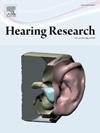Finite element analysis of the osseous spiral lamina’s influence on inner ear fluid flow during bone conduction stimulation
IF 2.5
2区 医学
Q1 AUDIOLOGY & SPEECH-LANGUAGE PATHOLOGY
引用次数: 0
Abstract
Recent studies have investigated the anatomy and motion of the human cochlear partition, revealing insights into the flexible nature of the osseous spiral lamina (OSL). These investigations have primarily focused on air-conducted stimulation, leaving the impact of the OSL’s flexibility during bone-conducted (BC) stimulation largely unexplored. By considering the OSL as either flexible or rigid in a finite element model of the human inner ear, we examined the effect of the OSL’s flexibility on the fluid flow in the inner ear during BC stimulation, which was divided into contributors entering via the oval window (OW) and rigid body stimulation.
Our results with rigid body stimulation indicate that the OSL facilitates an increased differential fluid flow at the round window compared to the OW, aligning with experimental observations interpreted as third window effects. Analysis of the OSL motion showed that this contribution results from a compressional motion of the OSL’s vestibular and tympanic plates which is significantly lower in magnitude than the plates’ translation in the direction of the stimulation. Separately applying OW input and rigid body stimulation provided insights into the interaction of BC sound entering via the OW and the reaction of the stapes to complex interior sound pressure distributions. Combined with the observations from a prior study (Kersten et al., 2024b) our results suggest a more important role for the OSL in BC hearing than previously understood. These findings enhance our understanding of the inner ear’s response during BC and contribute to ongoing investigations into the interaction of BC mechanisms, while highlighting the need for further research into the deformation of the cochlear boundaries.
骨传导刺激下骨螺旋板对内耳液流影响的有限元分析
最近的研究调查了人类耳蜗隔板的解剖和运动,揭示了骨螺旋板(OSL)的柔韧性。这些研究主要集中在空气传导刺激上,在骨传导(BC)刺激期间OSL灵活性的影响很大程度上未被探索。在人内耳的有限元模型中,我们考虑了OSL的柔性或刚性,研究了在BC刺激过程中OSL的灵活性对内耳流体流动的影响,该过程分为通过椭圆窗(OW)进入的贡献者和刚体刺激。我们对刚体刺激的研究结果表明,与低密度相比,OSL有助于增加圆窗处的微分流体流动,这与被解释为第三窗口效应的实验观察结果一致。对声索运动的分析表明,这种贡献是由于声索前庭和鼓室板块的压缩运动,其幅度明显低于刺激方向上的板块平移。分别应用声道输入和刚体刺激,可以深入了解通过声道进入的BC声音的相互作用以及镫骨对复杂内部声压分布的反应。结合先前研究的观察结果(Kersten et al., 2024b),我们的结果表明,在BC听力中,OSL的作用比以前所理解的更重要。这些发现增强了我们对BC期间内耳反应的理解,并有助于对BC机制相互作用的持续研究,同时强调了对耳蜗边界变形的进一步研究的必要性。
本文章由计算机程序翻译,如有差异,请以英文原文为准。
求助全文
约1分钟内获得全文
求助全文
来源期刊

Hearing Research
医学-耳鼻喉科学
CiteScore
5.30
自引率
14.30%
发文量
163
审稿时长
75 days
期刊介绍:
The aim of the journal is to provide a forum for papers concerned with basic peripheral and central auditory mechanisms. Emphasis is on experimental and clinical studies, but theoretical and methodological papers will also be considered. The journal publishes original research papers, review and mini- review articles, rapid communications, method/protocol and perspective articles.
Papers submitted should deal with auditory anatomy, physiology, psychophysics, imaging, modeling and behavioural studies in animals and humans, as well as hearing aids and cochlear implants. Papers dealing with the vestibular system are also considered for publication. Papers on comparative aspects of hearing and on effects of drugs and environmental contaminants on hearing function will also be considered. Clinical papers will be accepted when they contribute to the understanding of normal and pathological hearing functions.
 求助内容:
求助内容: 应助结果提醒方式:
应助结果提醒方式:


